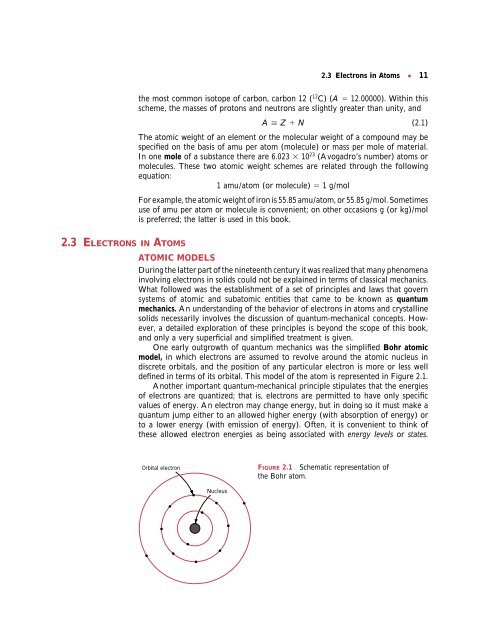Chapter 2 / Atomic Structure and Interatomic Bonding
Chapter 2 / Atomic Structure and Interatomic Bonding
Chapter 2 / Atomic Structure and Interatomic Bonding
You also want an ePaper? Increase the reach of your titles
YUMPU automatically turns print PDFs into web optimized ePapers that Google loves.
2.3 Electrons in Atoms ● 11<br />
the most common isotope of carbon, carbon 12 ( 12C) (A 12.00000). Within this<br />
scheme, the masses of protons <strong>and</strong> neutrons are slightly greater than unity, <strong>and</strong><br />
A Z N (2.1)<br />
The atomic weight of an element or the molecular weight of a compound may be<br />
specified on the basis of amu per atom (molecule) or mass per mole of material.<br />
In one mole of a substance there are 6.023 1023 (Avogadro’s number) atoms or<br />
molecules. These two atomic weight schemes are related through the following<br />
equation:<br />
1 amu/atom (or molecule) 1 g/mol<br />
For example, the atomic weight of iron is 55.85 amu/atom, or 55.85 g/mol. Sometimes<br />
use of amu per atom or molecule is convenient; on other occasions g (or kg)/mol<br />
is preferred; the latter is used in this book.<br />
2.3 ELECTRONS IN ATOMS<br />
ATOMIC MODELS<br />
During the latter part of the nineteenth century it was realized that many phenomena<br />
involving electrons in solids could not be explained in terms of classical mechanics.<br />
What followed was the establishment of a set of principles <strong>and</strong> laws that govern<br />
systems of atomic <strong>and</strong> subatomic entities that came to be known as quantum<br />
mechanics. An underst<strong>and</strong>ing of the behavior of electrons in atoms <strong>and</strong> crystalline<br />
solids necessarily involves the discussion of quantum-mechanical concepts. However,<br />
a detailed exploration of these principles is beyond the scope of this book,<br />
<strong>and</strong> only a very superficial <strong>and</strong> simplified treatment is given.<br />
One early outgrowth of quantum mechanics was the simplified Bohr atomic<br />
model, in which electrons are assumed to revolve around the atomic nucleus in<br />
discrete orbitals, <strong>and</strong> the position of any particular electron is more or less well<br />
defined in terms of its orbital. This model of the atom is represented in Figure 2.1.<br />
Another important quantum-mechanical principle stipulates that the energies<br />
of electrons are quantized; that is, electrons are permitted to have only specific<br />
values of energy. An electron may change energy, but in doing so it must make a<br />
quantum jump either to an allowed higher energy (with absorption of energy) or<br />
to a lower energy (with emission of energy). Often, it is convenient to think of<br />
these allowed electron energies as being associated with energy levels or states.<br />
Orbital electron<br />
Nucleus<br />
FIGURE 2.1 Schematic representation of<br />
the Bohr atom.



